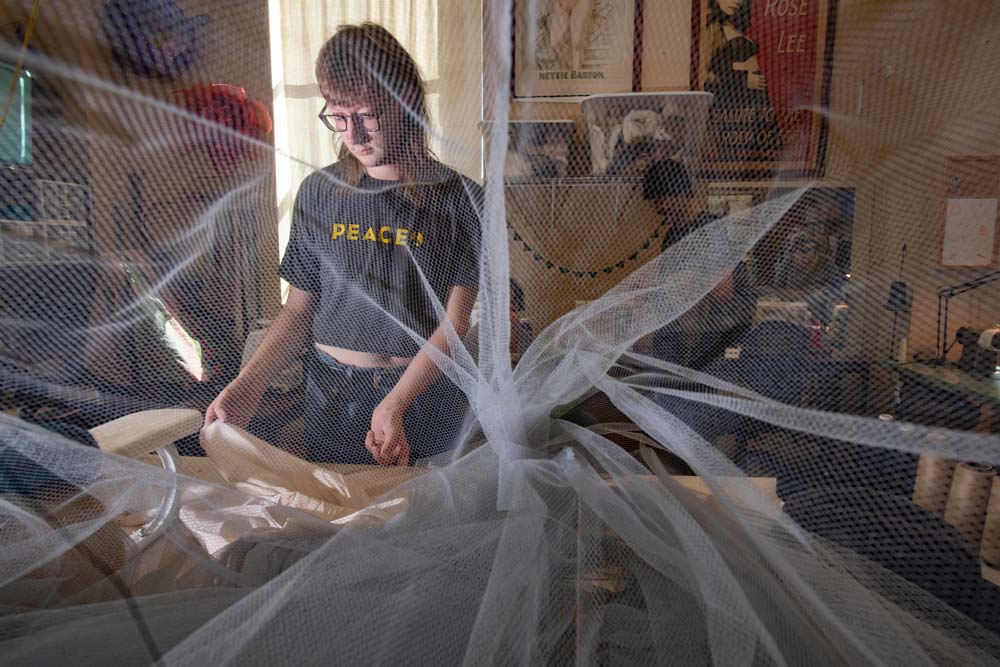




Hair-Raising Findings
Unique hair collection project gives students hands-on experience learning about small mammals of the southeast by Julia Hartbarger Duvall '15
From diet analysis to population density to home range, one can learn a lot from analyzing animal scat. Just ask Josh Johnson '23, who over the course of several months trekked up to the Balsam Mountain Preserve and other spots in the area to look for scat droppings from southeastern small mammals, hiking up to 10 miles per trip scouring the area.
“The main scat we collected was bobcat, coyote and fox,” Johnson said. “I would put the scat samples into a small clear bag, put it on ice and take it back for analysis by Dr. (Aimee) Rockhill and the student group.”
The reason for the scat collecting is for a carnivore resource partitioning project that Aimee Rockhill, associate professor in the Geosciences and Natural Resources Department at Western Carolina University, and her students have been working on over the past few semesters. The analysis included taking the scat and breaking it down in sifters to separate bone fragments and hair. The scat was then categorized and labeled.
Recent research confirms that while there is an understanding of how coyotes, bobcats and foxes use the landscape, it's very different on a local scale, particularly in the southeast. In temperate forests, coyotes tend to be more carnivorous, but that's due to their tendency to go more towards white tailed deer or elk. In Western North Carolina, there are low populations of both species, potentially increasing competition with other carnivores.
Understanding how that impacts other native species such as bobcats and gray foxes is critical. A key component to analyzing diet through scat is being able to accurately identify the variety of hairs that remain in each scat sample, something researchers have been doing for years but have yet to develop a digital database available for other researchers.
Rockhill and her students had an opportunity to develop this database through a National Science Foundation grant. Katherine Matthews, professor of biology at WCU, was the lead investigator for the grant and supported Rockhill and the student team throughout the process. “When the Apodaca Science Building was planned and developed, there was a need to ensure our biological collections were processed and packaged properly so they could handle the move and not be damaged,” Rockhill said. “Through this grant, we had the opportunity to expand our current biological collections for use in the classroom and research with students.
The overall purpose of the hair collection portion of the project is to create a publicly available digital database of mammalian hairs from across the southeast. “When you look at different species, there are broad, macroscopic morphological differences such as the length and diameter of the hair; but we are seeing a lot of variation microscopically in the scale and medulla patterns, even within an individual hair,” Rockhill said. “The struggle has been digitizing and archiving to have reference sets readily available in a digital format.”
Rockhill and her students’ overall goal was to capture the variation in both scale pattern and medulla pattern in all the hairs across the species of small mammals in the southeast and from various locations on each individual mammal’s body.


“We also look at the medulla, and that's essentially what gives hair its color. To make those slides, we use a solution called ‘Permount’ to permanently cast the hair onto a slide that can be viewed microscopically. We can then classify and characterize the patterns we see,” Rockhill said. Meredith Lloyd, a senior in the natural resource management and conservation program from Charlotte, who made more than 800 of the slides, shared her experience with the project.
“WCU students benefit from these hands-on learning experiences by really understanding all the components of a research project,” Lloyd said. “We see what does and does not work. Part of the project is looking at the individual species in the area and developing that reference set of slides based on those findings.” A thesis project conducted in Kentucky from 1969 catalogued 58 of the southeastern mammals but does not provide the high-resolution images needed.
“Back then we didn't have top-notch microscopes or the ability to digitize the images, so the reference set available to us was not high-quality enough to be able to identify species based on hair collected in our scat project,” Rockhill said. Rockhill and her students are hopeful that this digital database will save time for other researchers doing similar work across the country and provide a tool for other fields such as forensics.
“The most rewarding part of this project is knowing that the efforts being put forth will have implications further along in the scientific process for other researchers and managers,” said Eric Fanning, a senior from Stockbridge, Georgia, in WCU’s natural resource conservation and management program. “Not only this, but stunning visuals of fur structures, not often thought about by the naked eye, emerge from the computer screen when a microscope like this is on a single strand of fur.” The grant also allowed for adding to the mammal collection at WCU.


“We had low species diversity in our mammal collection,” Rockhill said. “One of the goals I really had for the students was to improve the collection, so when we teach classes like wildlife management and mammalogy, the students have something tangible to be able to better understand the diversity of mammals. It’s an added bonus that the students have been able to be so heavily involved in the process and learn new skills while supporting themselves through college.”
While Rockhill and her students were developing the collection, they realized that there really was a need not just for the study of skins and study skills, but also for the actual hair on those collections to add to the digital database. “Our collection at Western is still quite small and we have been working with the North Carolina Museum of Natural Sciences in Raleigh to build the collection,” Rockhill said. “We have been involved with them from the start. Every summer we send a group of students to Raleigh to work with the collections.”
Last summer, six students went to the museum as part of this project and they were able to collect hair from the specimens at the museum, which allowed the students to get samples from mammals throughout the entire Southeastern U.S.
“Students pulled from four different locations,” Rockhill said. “Most collections pull from the dorsal guard hairs, which is essentially between the shoulders. But our students were curious and came up with their own questions and pulled hair from the rump, sides and belly.” Collecting and analyzing samples isn’t the only involvement the students had.
“The students have been heavily involved with everything from the literature review and hypothesis to methods development,” Rockhill said. “On this project, some of the big questions were: ‘How do we develop this database? Which macro- and microscopic measurements are necessary for species identification? How much variability is there by species, family, or order? Which outlet is best to make the collection publicly available?’ We have also been going through the process of just making sure we’ve thought of everything and asked all the important questions.”
As part of the grant, Lisa Gatens from the North Carolina Museum of Natural Sciences, came to Cullowhee in April to work with students on live trapping small mammals for population estimates at WCU’s Gribble Gap property and teaching students how to properly prepare museum quality study skins from road-killed mammals that will help build WCU’s mammal collection.
“The student groups started out by assembling traps and placing bait in them, then labeled the traps and set them out in a gridded pattern near WCU’s Health and Human Sciences building,” Gatens said. “These humane live traps are checked twice per day, and we put oats, sunflower seeds and cotton balls to give the mammals a cozy bed and snack while they wait to be released.”
The purpose of live trapping is to give students experiential learning opportunities with techniques commonly used in wildlife management. Students learn to set trapping grids, handle animals, and identify, age, and sex species. In the classroom, students can estimate species diversity, home range and population densities. Gatens and Rockhill were especially interested in possibly catching golden mice, a species that is rare to catch in the area but was captured back in 2019.

“Golden mice are rarely captured and records are lacking in this region so we would like to document their presence and learn more about their distribution,” Rockhill said. “We mark the mice with numbered ear tags and a sharpie mark on their belly and release them in the same spot they were captured. Running traps for 4 days and uniquely marking each individual one allows students to conduct population estimates on the small mammals.” While the traps were out, students went and recorded data twice per day over a week-long period.
Another project that the students worked on with Gatens was taking a road-killed bobcat and beaver and removing the skins and stuffing them to make museum quality specimens for students to study at WCU.
Nine students have been hired on the multiple projects to date and four students continued working on the database through the end of the summer. Several students, such as Fanning, remained on campus to work over the summer on various projects. This project has opened doors for Fanning to pursue a senior thesis this summer on a different project in collaboration with Rockhill and colleagues at Clemson. The project focuses on moon phase impacts on coyote movement rate and habitat use.
“A lot of our students do have to work to support themselves,” Rockhill said. “Having access to these grant funds allows us to employee them here, so they are earning money while building critical skills in their field and ultimately improving their resume, so they are more marketable when they graduate.”
This past summer, some of the students traveled with Rockhill to Anchorage, Alaska, to present their findings for the digital database at the International Mammalogical Congress meeting. “This database will be the first publicly available digital database on Southeastern mammal hairs and will be available through Symbiota,” Rockhill said. Asked what the most important part of wildlife management is, Rockhill brought it back to a simple mindset:
“I like to think of everything from a landscape scale perspective with a focus on our anthropogenic footprint,” Rockhill said. “It is difficult to manage wildlife without an understanding of how we impact their use of the biotic and abiotic characteristics of the land; whether human induced or natural. My goal as a researcher is to build a better understanding of how wildlife use this complex landscape so we can better manage our resources and in turn help sustain wildlife populations for future generations.”
Asked what he hoped the database would look like in 5-10 years, Fanning was hopeful advancements in technology would benefit the growth of the collection. “I hope to see the integration of AI learning tools, to produce micro-measurements at scales far beyond practical human efforts, on single strands of fur,” Fanning said. “This could provide much further insight into tendencies between species, benefiting wildlife managers and researchers.”

